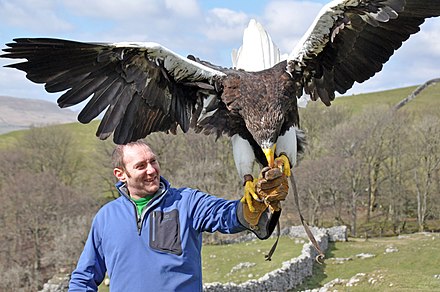Steller’s sea eagles are known for their impressive size, with females being larger and heavier than males. These majestic birds engage in spectacular courtship displays, including acrobatic flight maneuvers, to attract a mate. Their unique physical traits and complementary roles in breeding and hunting also play a crucial role in the mating process.
Impressive Size and Physical Traits
Steller’s sea eagles are characterized by their large size, with females being significantly larger and heavier than males. This size difference is advantageous for the species, as larger females can endure longer periods without food during incubation, and their presence serves as a formidable defense for the eggs.
| Physical Trait | Females | Males |
|---|---|---|
| Size | Larger and heavier | Slightly smaller and more agile |
| Back Talons | Larger | Slightly smaller |
| Bill Hook | Larger | Smaller |
The larger back talons and bill hook of female Steller’s sea eagles are also important physical traits that contribute to their mating success. These features allow them to be more effective in defending the nest and protecting their eggs and hatchlings.
Spectacular Courtship Displays
 Image source: stellers sea eagle
Image source: stellers sea eagle
Steller’s sea eagles engage in impressive courtship displays to attract a mate. One of the most well-known displays is the “cartwheel display,” where the pair flies to great altitude, locks their talons in flight, and tumbles in cartwheels back toward the earth, breaking off their hold at the last moment before colliding with the ground.
These acrobatic flight displays often occur in winter, suggesting that many pairs remain bonded through the year. The spectacular nature of these displays serves to showcase the eagles’ strength, agility, and coordination, which are all desirable traits for a potential mate.
Complementary Roles in Breeding and Hunting
During the breeding season, Steller’s sea eagles exhibit distinct behavioral differences between the sexes. Females primarily take on the role of incubating the eggs and fiercely protecting the nest, while males focus on hunting to provide food for themselves, their mates, and their offspring.
This division of labor is crucial for the successful rearing of the eagles’ offspring. The larger and more aggressive females are better suited for the demanding task of incubation and nest defense, while the males’ hunting skills ensure a steady supply of food for the family.
Determining the Sex of Steller’s Sea Eagles
To determine the sex of a Steller’s sea eagle, one can observe their size, behavior, and physical traits. Females are larger and heavier, with larger beaks and talons, and they exhibit heightened aggression and territoriality during nesting. Males, on the other hand, are slightly smaller and more agile, making them better adapted for hunting.
By understanding these physical and behavioral differences, researchers and birdwatchers can more accurately identify the sex of individual Steller’s sea eagles, which is important for studying their mating and breeding habits.
In conclusion, Steller’s sea eagles attract a mate through a combination of their impressive size, acrobatic flight displays, and complementary roles in incubating eggs and hunting for food. These unique characteristics and behaviors have evolved to ensure the successful reproduction and survival of this magnificent species.

